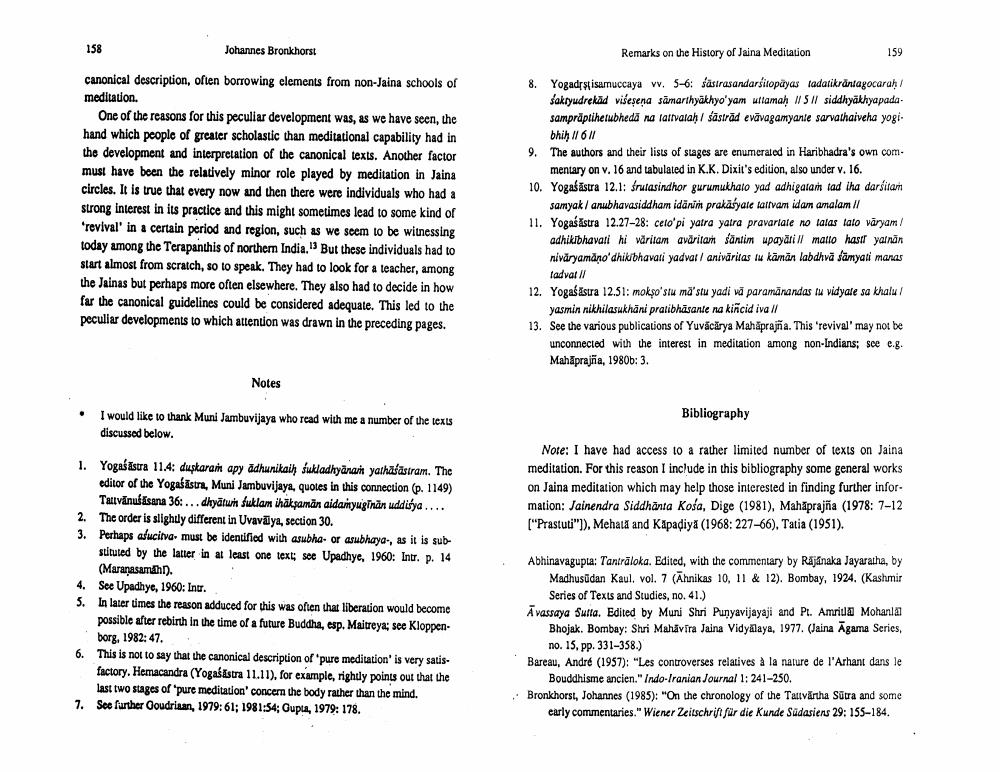Book Title: Remarks On History Of Jaina Meditation Author(s): Johannes Bronkhorst Publisher: Johannes Bronkhorst View full book textPage 5
________________ 158 Johannes Bronkhorst Remarks on the History of Jaina Meditation 159 canonical description, often borrowing elements from non-Jaina schools of meditation. One of the reasons for this peculiar development was, as we have seen, the hand which people of greater scholastic than meditational capability had in the development and interpretation of the canonical texts. Another factor must have been the relatively minor role played by meditation in Jaina circles. It is true that every now and then there were individuals who had a strong interest in its practice and this might sometimes lead to some kind of "revival' in a certain period and region, such as we seem to be witnessing today among the Terapanthis of northern India." But these individuals had to start almost from scratch, so to speak. They had to look for a teacher, among the Jainas but perhaps more often elsewhere. They also had to decide in how far the canonical guidelines could be considered adequate. This led to the peculiar developments to which attention was drawn in the preceding pages. 8. Yogadrstisamuccaya w. 5-6: fästrasandarsitopayas tadatikräntagocarah/ Saktyudrekid viseșena sāmarthyākhyo'yam ullamah Il 5 l/ siddhyakhyapadasampraptiherubheda na lattvalah / śāstrād evāvagamyante sarvathaiveha yogi. bhih // 6 11 9. The authors and their lisus of stages are enumeraled in Haribhadra's own com mentary on v. 16 and tabulated in K.K. Dixit's edition, also under v. 16. 10. Yogaśāstra 12.1: śrulasindhor gurumukhato yad adhigaram tad iha darsitam samyak / anubhavasiddham idānim prakāsyale tattvam idam amalam // 11. Yogaśāstra 12.27-28: celo'pi yatra yatra pravarlare no latas lalo vāryam/ adhikbhavati hi väritam avāritam santim upayāri Il matto hasil yarnăn nivăryamano'dhik bhavati yadvat / anivāritas iu kämän labdhva sämyati manas tadvalil 12. Yogasastra 12.51: mokşo'stu mā'stu yadi vã paramānandas tu vidyale sa khalu / yasmin nikhilasukhāni pratibhāsante na kincid iva II 13. See the various publications of Yuvācārya Maháprajña. This revival' may not be unconnected with the interest in meditation among non-Indians: see c.8. Mahāpraja, 1980b: 3. Notes Bibliography I would like to thank Muni Jambuvijaya who read with me a number of the texts discussed below. Note: I have had access to a rather limited number of texts on Jaina meditation. For this reason I include in this bibliography some general works on Jaina meditation which may help those interested in finding further infor. mation: Jainendra Siddhānta Koša, Dige (1981), Mahāprajña (1978: 7-12 ("Prastuti"]). Mehala and Kapadiya (1968: 227–66), Tatia (1951). 1. Yogaśāsta 11.4: duskarai apy adhunikaih sukladhyanak yathalastram. The editor of the Yogaśāsts, Muni Jambuvijaya, quotes in this connection (p. 1149) Tattvānuasana 36: ...dhyātuit fuklan ihäkpamān aidanyuginan uddisya.... 2. The order is slightly different in Uvavālya, section 30. 3. Perhaps afucitvamust be identified with asubha- or asubhaya-, as it is sub stituted by the latter in at least one text; see Upadhye, 1960: Intr. p. 14 (Maranasamahn). 4. See Upadhye, 1960: Iner. 5. In later times the reason adduced for this was often that liberation would become possible after rebirth in the time of a future Buddha, esp. Maitreya: see Kloppen borg, 1982:47. 6. This is not to say that the canonical description of pure meditation is very satis factory. Hemacandra (Yogaśastra 11.11), for example, rightly points out that the last two stages of "pure meditation concern the body rather than the mind. 7. See further Goudriaan, 1979:61; 1981:54; Gupta, 1979: 178. Abhinavagupta: Tantrāloka. Edited, with the commentary by Rajánaka Jayaratha, by Madhusudan Kaul. vol. 7 (Ahnikas 10, 11 & 12). Bombay, 1924. (Kashmir Series of Texts and Studies, no. 41.) A vassaya Sutta. Edited by Muni Shri Punyavijayaji and PL. Amrita Mohanlal Bhojak. Bombay: Shri Mahāvīra Jaina Vidyalaya, 1977. (Jaina Agama Series, no. 15. pp. 331-358.) Barcau, Andre (1957): "Les controverses relatives à la nature de l'Arhant dans le Bouddhisme ancien." Indo-Iranian Journal 1: 241-250. Bronkhorst, Johannes (1985): "On the chronology of the Tautvärtha Süra and some early commentaries." Wiener Zeitschrift für die Kunde Südasiens 29: 155-184.Page Navigation
1 ... 3 4 5 6 7
